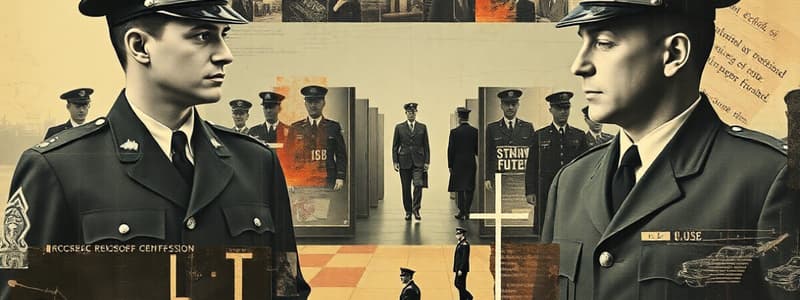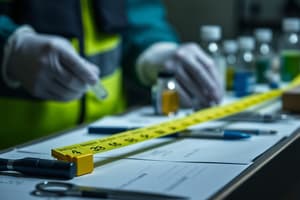Podcast
Questions and Answers
What distinguishes a reserve officer from other police personnel?
What distinguishes a reserve officer from other police personnel?
- They work only during emergencies.
- They are sworn members of a law enforcement agency. (correct)
- They are compensated significantly more than regular officers.
- They have no police powers.
What is a precinct house primarily used for?
What is a precinct house primarily used for?
- Community engagement and public relations.
- Training and development for police officers.
- Operational support for patrol units.
- Administrative headquarters for the precinct. (correct)
Which of the following best describes 'beats' in police work?
Which of the following best describes 'beats' in police work?
- A large area that includes several precincts.
- A unit dedicated to community service outreach.
- The patrol method preferred by officers.
- The smallest geographic area a patrol unit can effectively cover. (correct)
Which tour condition is noted for being the busiest for police officers?
Which tour condition is noted for being the busiest for police officers?
What is the primary focus of administrative units within a police department?
What is the primary focus of administrative units within a police department?
What is a common duration for a police tour?
What is a common duration for a police tour?
Which role is primarily responsible for supervising all activities in the station house?
Which role is primarily responsible for supervising all activities in the station house?
Which of the following describes auxiliaries within law enforcement?
Which of the following describes auxiliaries within law enforcement?
What are the three components of a police department?
What are the three components of a police department?
What is meant by 'unity of command' in a police organization?
What is meant by 'unity of command' in a police organization?
What is the recommended span of control for effective supervision of police officers?
What is the recommended span of control for effective supervision of police officers?
Which factors contribute to the success of shared leadership models in police organizations?
Which factors contribute to the success of shared leadership models in police organizations?
What defines a sworn member within a police department?
What defines a sworn member within a police department?
What role does a sergeant play in the chain of command?
What role does a sergeant play in the chain of command?
How did the NYPD's CompStat program impact its management structure?
How did the NYPD's CompStat program impact its management structure?
What is the primary duty of patrol officers in a police department?
What is the primary duty of patrol officers in a police department?
Flashcards are hidden until you start studying
Study Notes
Division of Labor
- Police departments are organized by division of labor, considering: personal, area, time, function, and purpose.
Managerial Definitions
- Police departments consist of three basic components: People, Activities, and a Specific Goal.
- Crime fighting occupies only 20% of police officers' time.
Chain of Command - Hierarchy of Authority
- A managerial concept describing the relationship between supervisors and subordinates.
- Every individual is supervised by one immediate supervisor.
- Smaller departments tend to have more intimate relationships between supervisors and subordinates.
Span of Control
- The number of officers a superior can effectively supervise.
- Management research indicates the optimal span of control is 6 to 10 officers.
Delegation of Responsibility and Authority
- Tasks, duties, and responsibilities are assigned with corresponding authority.
Unity of Command
- Each individual is directly accountable to their supervisor.
Alternative Managerial Models and Structures
- Shared leadership model incorporates subordinates into decision-making processes.
- Research indicates significant improvements in departments that utilize shared leadership models.
- Successful shared leadership models require trust and strong communication skills.
NYPD's CompStat Program
- Decentralized management structure.
- Since 1992, New York City has experienced an 85% decrease in crime rates.
Sworn vs. Nonsworn Personnel
- Sworn members possess traditional police powers, including upholding federal, state, and local criminal laws. This includes police officers, troopers, and deputy sheriffs, who take an oath of office.
- Nonsworn members are assigned to non-enforcement roles, considered civilian positions. This includes civilian investigators, crime analysts, dispatchers, equipment managers, and records management personnel. They have limited arrest powers as they are not licensed to carry firearms.
Highly Organized Rank Structure
- Chief of Police/Police Commissioner - The head of the agency.
- Captain - In charge of an operational or administrative area of the police department.
- Lieutenant - Responsible for an entire platoon (all officers on a particular tour/shift).
- Sergeant - The first supervisor in the chain of command. Supervises a squad (group of 10 officers) and makes decisions at the scene of police actions.
- Corporal/Master Patrol Officer
- Police Officer
- Detective/Investigator
Patrol Officers
- Perform the basic duties of the police department.
Precincts/Districts/Stations
- The entire collection of beats in a geographic area.
Precinct House or Station House
- The administrative headquarters for a precinct.
Desk Officer
- A sergeant or lieutenant who supervises all activities in the station house.
The Three-Tour System
- Divides each 24-hour period into three shifts to distribute manpower.
- This system does not always align with crime patterns.
Tour Length
- The most common tour length is eight hours.
- Ten-hour tours are also common.
- Twelve-hour tours are increasing, but concerns exist about officer fatigue.
Overtime Issues
- Officers must complete all assigned tasks before leaving for the day.
Tour Conditions
- Day Tour: Focuses on:
- Construction
- Traffic flow
- Schools
- Police hot spots (commercial areas)
- Other police services
- Evening Tour: The busiest tour for police.
Line and Staff (Support) Functions
- Line Functions: Directly connected to the organization's goals.
- Staff (Support) Functions: Supplement line units in their task performance.
Police Department Units
- Operational Units: Focus on policing activities directly related to the agency's goals.
- Administrative Units: Not directly related to the public. They facilitate smooth agency operations, including:
- Personnel
- Planning and Analysis
- Budget
- Clerical Work
Reserve Officers
- Volunteers and non-regular members of law enforcement agencies.
- Sworn members with full police powers.
- Serve with or without compensation.
Auxiliaries
- Volunteer officers in law enforcement agencies who have limited authority.
Beats
- The smallest geographic area that a single patrol unit can effectively patrol, using various methods: foot, bike, car, or horse patrol.
- Ideally, officers should know everyone in their beat, and beats should not be too large.
Studying That Suits You
Use AI to generate personalized quizzes and flashcards to suit your learning preferences.




